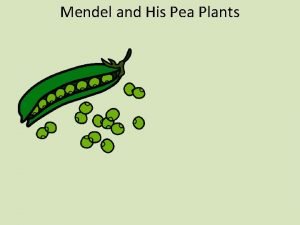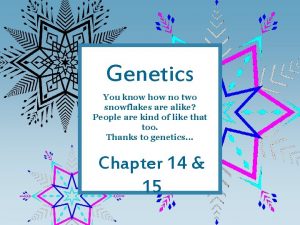Relative importance of genotypic richness vs phenotypic plasticity

- Slides: 1

Relative importance of genotypic richness vs. phenotypic plasticity on productivity under manipulated drought conditions Cynthia Chang 1, Rebecca Kim 1, Elizabeth Nightingale 1, Erica Qiao 1, Meerit Said 1, Stefany Sideris 1, Nicholas Vradenburg 1 1 Division of Biological Science, University of Washington, Bothell, WA METHODS Species: Arabidopsis thaliana - Genotypes A, B, C, D, E, F from un. PAK seed lines. Greenhouse experimental design: Seeds were planted according to diversity and water treatment (see table below). Position in pot was randomized. ➤ Each combination of diversity treatment was duplicated and grown under low-water and highwater treatment. ➤ Low water treatment: each pot was given 25 m. L every 2 days for the first 2 weeks, then 50 m. L every 2 days ➤ High water treatment: each pot was given 50 m. L every 2 days for the first 2 weeks, then 100 m. L every 2 days INTRODUCTION RESEARCH QUESTIONS Studies have suggested that intraspecific genetic diversity influences ecosystem structure and functioning (Whitlock 2014). Epigenetic diversity has been shown to increase productivity by up to 40% in Arabidopsis thaliana populations (Latzel et al. 2013). Phenotypic plasticity (the ability of a genotype to alter its phenotype under varied environmental conditions) has been studied frequently, but the role it plays on diversity-productivity relationships is not well known. We conducted a greenhouse experiment to further investigate the roles genetic diversity and phenotypic plasticity play on productivity in plant populations. ➤ Do certain phenotypes exhibit more plasticity compared to others? ➤What is the relationship between genotype richness and productivity under drought and non-drought conditions? ➤What is the relative importance between plasticity index and productivity under drought and non-drought conditions? FIGURES RESULTS & FUTURE WORK Table 1: Summary of Diversity Treatment, Genotype Richness and given Plasticity (B) (A) (C) Results: ➤ Phenotypic Plasticity is defined as the ability to change in response to fluctuation in the environment. Certain genotypes have higher phenotypic plasticity than others, meaning they are able to survive better in both drought and non-drought conditions. (Fig. 1) ➤ Diversity treatment combinations composed (A) of genotypes with higher propensity for 2 Fig 1: Effects of drought and non-drought conditions on individuals grown alone for (A) Fitness (# of seed pods), N≈15* [A: r =3. 6 e phenotypic plasticity had greater overall (A) -2] [B: r 2=2. 1 e-4] [C: r 2=1. 1 e-2] [D: r 2=4. 3 e-2] [E: r 2=3. 5 e-1)] [F: r 2=9. 9 e-6]. (B) Aboveground Biomass (g), N≈15* [A: r 2=. 37] [B: r 2=. 029] fitness (# of seed pods) and (B) aboveground [C: r 2=. 51] [D: r 2=. 41] [E: r 2=. 32] [F: r 2=. 26]. (C) Specific Leaf Area (mm 2/g), N≈15* [A: r 2=. 12] [B: r 2=. 036] [C: r 2=. 035] [D: r 2=. 038] [E: biomass (grams) in both drought and nonr 2=. 016)] [F: r 2=. 051]. drought conditions, but not in (C) Specific Leaf *Except for genotype C due to low germination and survival rate. Area (mm 2/g). (Fig 1) ➤ There was a weak negative relationship between genotype richness (Fig. 2. ) and productivity and weak positive relationship between and plasticity index (Fig. 3. ) and productivity, and the strength of these relationships differred between drought and non-drought conditions. Data collection: ➤ Experiment was terminated after 48 days. ➤ Measured: specific leaf area of a single harvested leaf, plant fitness (number of seed pods), aboveground biomass of each harvested and dried individual. Fig 2: Correlation between Genotype Richness and Productivity [r 2=-. 001977, p=. 4833>. 05] Fig 3: Correlation between Plasticity Index and Productivity [r 2=. 0008058, p=. 2737>. 05] REFERENCES ➤ Latzel V, Allen E, Bortolini Silveira A, Colot V, Fischer M, Bossdorf O. Epigenetic diversity increases the productivity and stability of plant populations. Nature Communications; 2013. 2875(4): 1 -7 ➤ Whitlock R. Relationships between adaptive and neutral genetic diversity and ecological structure and functioning: a meta-analysis. Journal of Ecology; 2014. 102 (1): 857 -872. ➤ Acknowledgements: UWB Biology Division • BBIO 471 Plant Ecology Class 2015 • Sara-Beth Burkett • Dalton Wheeler • Tanya Kumar • Tyson Kemper • Cristy Cherrier • Kelly Carter-Lynn • un. PAK Network: Courtney Murren, April Bisner Conclusion & Future Work: ➤ Together, these findings suggest to focus future work on facets of intraspecific variation in agricultural and forest species response to climate change (droughts and floods) that is important in the richness-productivity and plasticity-productivity relationships. We also argue for a more explicit testing of assessing genotypes based on not only their mean trait value (heritability), but also their plasticity index. This may be essential for identifying genotypes of agricultural and forest species efficient in increasing or maintaining productivity under varied climate conditions.

